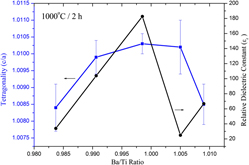Crossref Citations
This article has been cited by the following publications. This list is generated based on data provided by Crossref.
Yoon, Seok-Hyun
Kim, Sun-Jung
Kim, Sang-Hyuk
and
Kim, Doo-Young
2013.
Influence of excess Ba concentration on the dielectric nonlinearity in Mn and V-doped BaTiO3 multi layer ceramic capacitors.
Journal of Applied Physics,
Vol. 114,
Issue. 22,
Hou, Dong
Usher, Tedi-Marie
Zhou, Hanhan
Raengthon, Natthaphon
Triamnak, Narit
Cann, David P.
Forrester, Jennifer S.
and
Jones, Jacob L.
2017.
Temperature-induced local and average structural changes in BaTiO3−xBi(Zn1/2Ti1/2)O3 solid solutions: The origin of high temperature dielectric permittivity.
Journal of Applied Physics,
Vol. 122,
Issue. 6,
Hong, Kootak
Lee, Tae Hyung
Suh, Jun Min
Yoon, Seok-Hyun
and
Jang, Ho Won
2019.
Perspectives and challenges in multilayer ceramic capacitors for next generation electronics.
Journal of Materials Chemistry C,
Vol. 7,
Issue. 32,
p.
9782.
Li, Cheng
Fu, Shuyi
Han, Hongsong
Wang, Wenzhong
Fu, Junli
Shi, Honglong
Liang, Yujie
Jia, Ying
and
Zhu, Min
2019.
Synthesis and SPEF-Induced Enhanced Photoelectrochemical Performance of the BaTiO3@α-Fe2O3 Ferroelectric Heterojunction.
The Journal of Physical Chemistry C,
Vol. 123,
Issue. 36,
p.
22431.
Yang, Jinlun
Mao, Haijun
Chen, Xingyu
and
Zhang, Weijun
2019.
Investigation of microstructure and dielectric properties of LaMnO3 doped BaTiO3 ceramics.
Journal of Materials Science: Materials in Electronics,
Vol. 30,
Issue. 19,
p.
18227.
Lukacs, Vlad Alexandru
Stanculescu, Roxana
Curecheriu, Lavinia
Ciomaga, Cristina Elena
Horchidan, Nadejda
Cioclea, Cipriana
and
Mitoseriu, Liliana
2020.
Structural and functional properties of BaTiO3 porous ceramics produced by using pollen as sacrificial template.
Ceramics International,
Vol. 46,
Issue. 1,
p.
523.
Chen, Fukang
Zhang, Yilin
Li, Yang
Yan, Yan
Yang, Lishun
Zeng, Xinyu
Deng, Tao
Nie, Huanghui
Liu, Gang
and
Zhang, Lixue
2023.
The effects of R2O3 (R=La, Yb, Gd) on the microstructure, dielectric, ferroelectric, and energy storage properties of Ba0.65Bi0.07Sr0.245TiO3 relaxor ferroelectric ceramics.
Ceramics International,
Vol. 49,
Issue. 2,
p.
2626.
Wang, Pengfei
Zhang, Lei
Huang, Xiong
Yang, Jun
Li, Bo
Yu, Shuhui
Sun, Rong
Fu, Zhenxiao
and
Cao, Xiuhua
2023.
Exceptional reliability of MLCCs enabled by defect‐engineered BaTiO3.
Journal of the American Ceramic Society,
Vol. 106,
Issue. 6,
p.
3613.
Yang, Lei
Zhu, Anzheng
Huang, Xiaodong
Deng, Chonghai
Hu, Kunhong
Yu, Hai
and
Lv, Jianguo
2024.
Ferroelectric spontaneous polarization assisted TiO2@BaTiO3@Ag photoanode for efficient photoelectrochemical water splitting via BaTiO3 phase regulation.
International Journal of Hydrogen Energy,
Vol. 55,
Issue. ,
p.
997.





